If you buy through our links, we may earn an affiliate commission. This supports our mission to get more people active and outside.Learn about Outside Online's affiliate link policy
The 7 Best Women’s Wide All-Mountain Skis of 2026
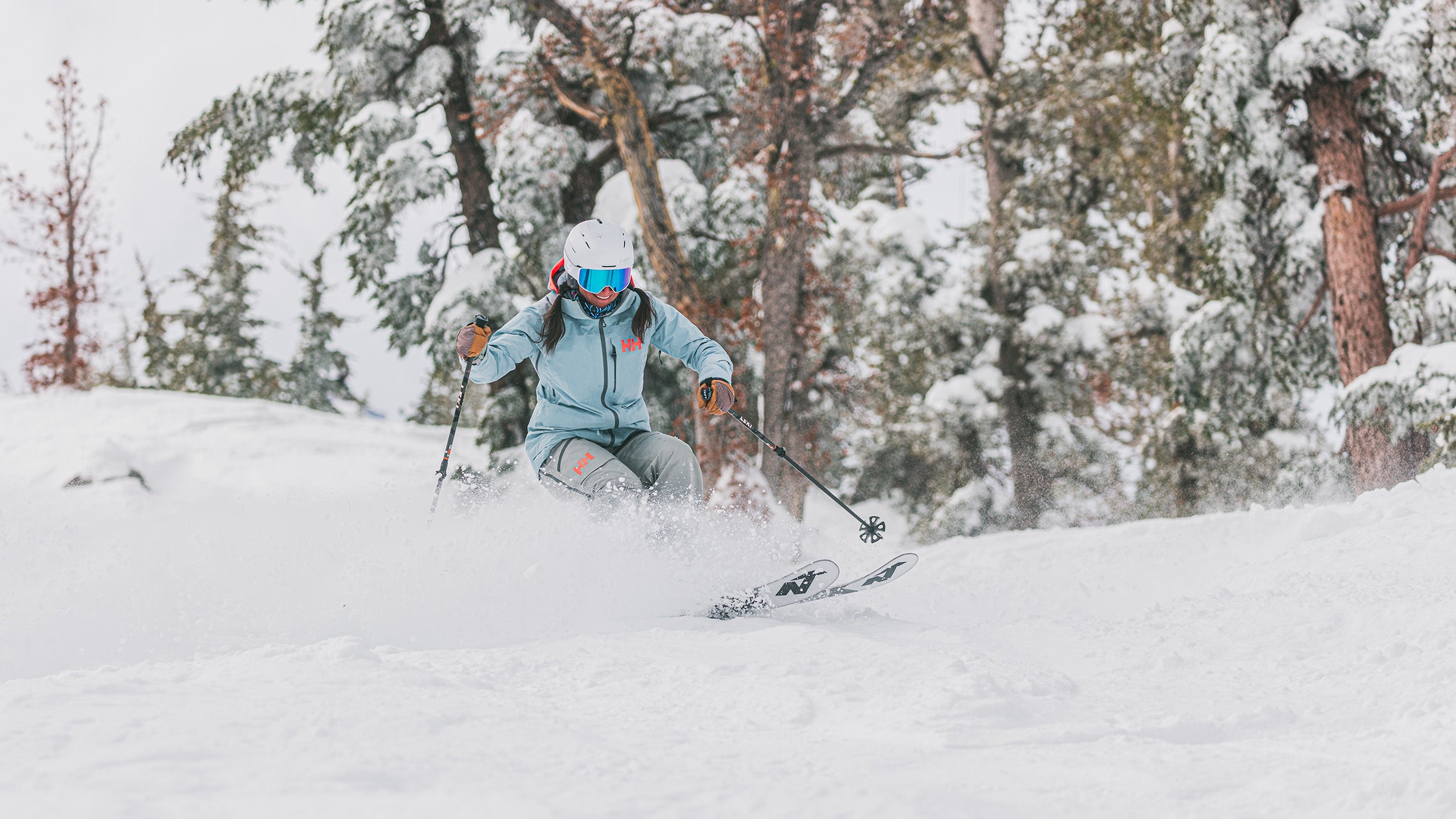
(Photo: Emily Tidwell)
Table of Contents
The wide all-mountain ski category celebrates soft snow—and the nuanced art of skiing it. The waists are a little wider (between 100 to 110 mm), the rocker a little steeper, and the constructions a little friendlier and geared toward finesse. The best wide all-mountain skis for women thrive in untracked trees, bowls, and chutes, but they’re not so cumbersome that they ignore your input on the groomer back to the lift.
Who needs a wide all-mountain ski? Those who ski the whole mountain—no matter the conditions. That’s when you want a wider tool that can do it all: Float on top of crud, flow through moguls, arc on groomers, and, of course, surf through the deep. Wide all-mountain skis are often everyday drivers for Westerners, or part of a storm cycle specialists’ quiver. –
We tested 13 wide all-mountain skis for women at our 2025 test in Big Sky, Montana, hunting for the planks that perform best when conditions get deep and diverse. The seven best women’s wide all-mountain skis listed here impressed with their versatility across terrain type, crud-busting capability, and flotation factor.
Best Women’s Wide All-Mountain Skis: At a Glance
- Best in Test: Rossignol Rallybird Soul 102 ($750)
- Most Approachable: Atomic Maven 103 CTi ($800)
- Best Value: Salomon QST 100 ($700)
- Best for Firm Conditions: Nordica Santa Ana 102 ($900)
- Best for Powder: Blizzard Sheeva 10 ($850)
- Most Forgiving: Head Kore 104 Ti W ($799)
- Most Playful: Armada ARW 100 ($700)
More Skis We Recommend
The Reviews: The Best Women’s Wide All-Mountain Skis
Of the 16 women’s all-mountain skis we tested at our annual SKI Test in Big Sky, Montana, these six stood out as top performers. They earned the highest marks across nine scoring criteria, with especially strong results in versatility and crud performance—the two performance characteristics we prioritize when reviewing all-mountain skis. Read more about our testing process here.
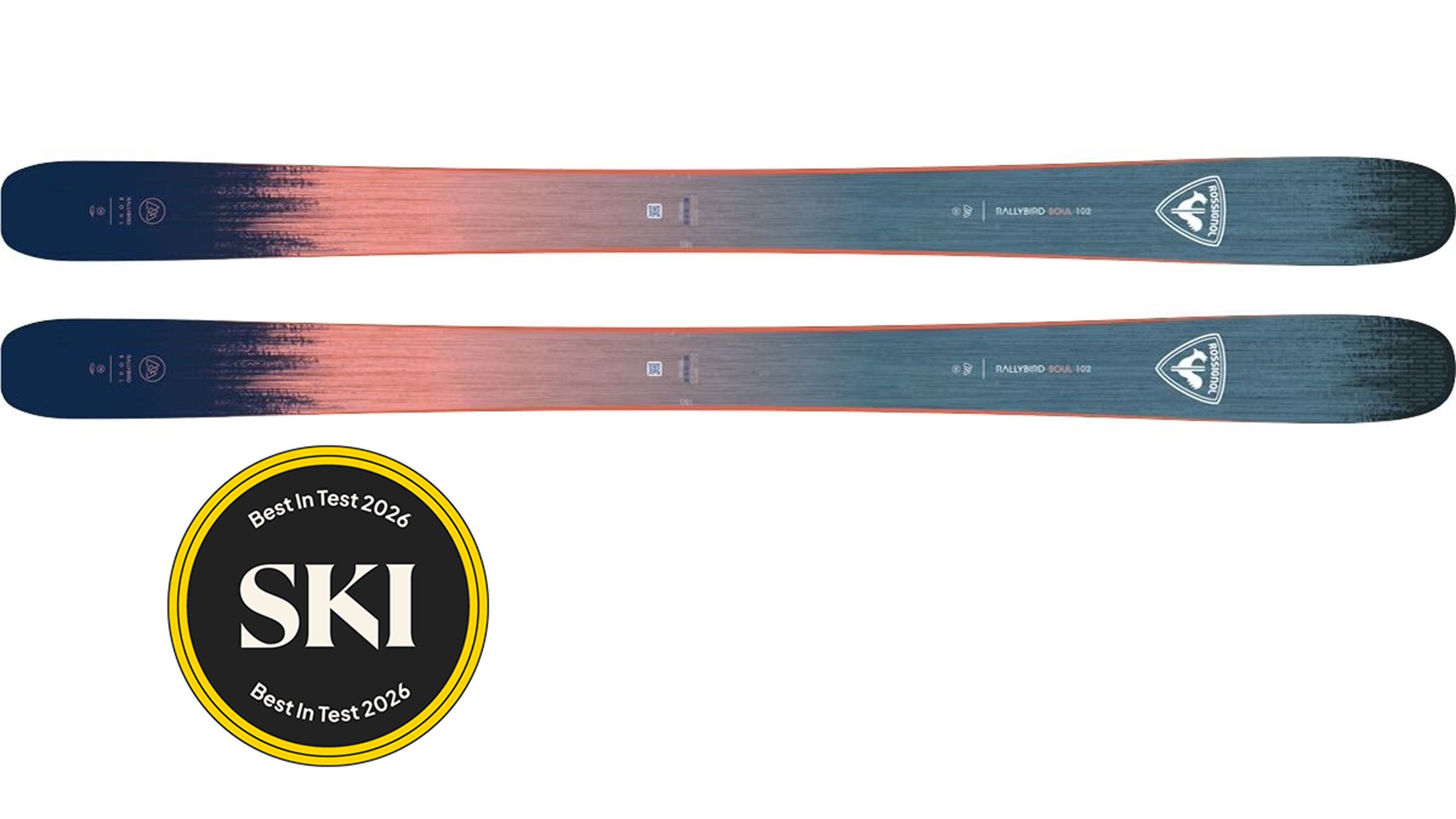
Best in Test: Rossignol Rallybird Soul 102
Dimensions: 135-101-125 mm
Available lengths: 150, 156, 164, 172
Pros and Cons
⊕ Exceptionally versatile
⊕ Perfect for surfing fluff
⊕ Stable
⊗ Best appreciated by experts
⊗ Prefers longer turns
We named the Rossignol Rallybird Soul 102 the best women’s wide all-mountain ski of 2025, and it returns, unchanged, as our top pick this year. No other ski proved as versatile or as dependable in crud at our test in Big Sky. Testers felt the Rallybird Soul 102 seamlessly bridges the gaps between ease and power, comfort and precision, energy and dampness. But what really sets this ski apart is its remarkable ability to read your mind: Whether you’re aggressively charging or just cruising casually, the Rallybird Soul 102 adjusts its personality to match.
With a rockered chassis for playfulness and flotation, the same rubber-inlay construction that made the iconic Rossignol Soul 7 so smooth, and strategic metal placement underfoot for edge grip, the Rallybird Soul 102 is a ski that adapts to any type of terrain or snow conditions.
As for quibbles, some felt it could be more forgiving, saying it takes muscle to make short turns. “It’s not the most accessible in the category and better suited to advanced and expert skiers,” said Outside’s associate gear director Jenny Wiegand. All agreed, however, that the Rallybird Soul 102 is not just a revival of Rossignol’s greatest ski of all time, the Soul 7, but a veritable evolution—a concept built from decades of Rossignol listening and learning. In a category crowded with capable skis, this one truly shines. Read the full review here.
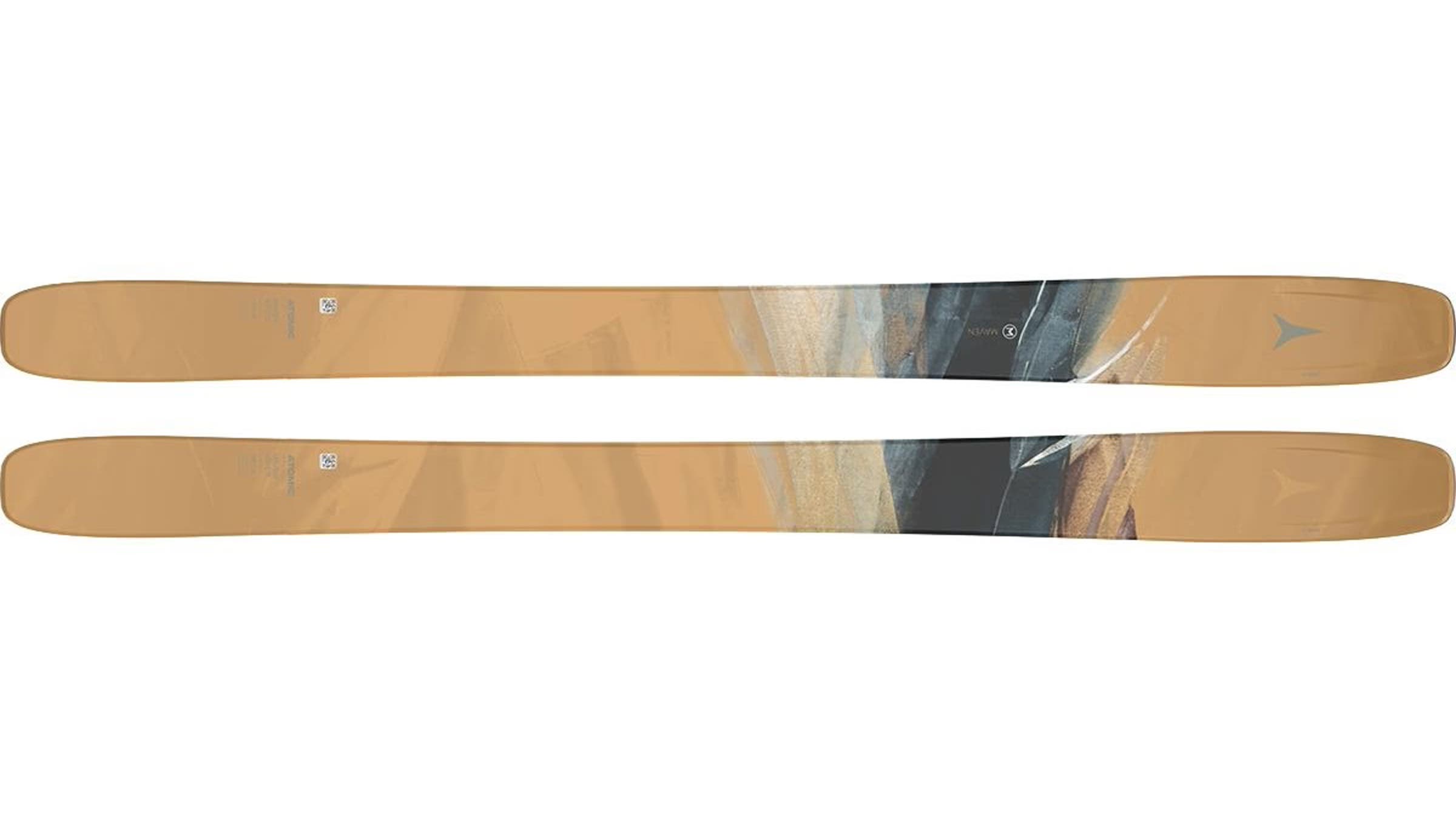
Most Approachable: Atomic Maven 103 CTi
Dimensions: 128.5-103-117.5 mm 2 162
Lengths: 156, 162, 170, 178 cm
Pros and Cons
⊕ Lightweight
⊕ Huge sweet spot
⊗ Chatters at speed
⊗ Not as dependable in crud
The Atomic Maven 103 CTi is a lightweight, nimble ski that smears effortlessly through tight trees and pivots on a dime. Its huge sweet spot never punishes you for getting a little backseat, making it approachable for intermediates while offering plenty of performance for experts. With a poppy rebound, it gives back whatever energy you put in—and then some.
This ski truly shines in soft snow, where its playful personality comes alive. During our test, however, conditions were less than ideal (“puckering,” as one tester put it), which exposed its lighter build and made it feel less confident at top speed on firm snow. Even so, it transitions seamlessly from groomers to bumps to trees and responds quickly to input, staying lively edge to edge.
The Maven’s steeply rockered tips can feel a bit chattery in frozen, uneven snow, but its ash and poplar wood core reinforced with Titanall and carbon provides a balanced blend of power and agility. “The most fun I’ve had on skis all season,” said Snowbasin tester Avery Pesce, who’s 5 feet 6 inches tall and skied the 178-centimeter length.
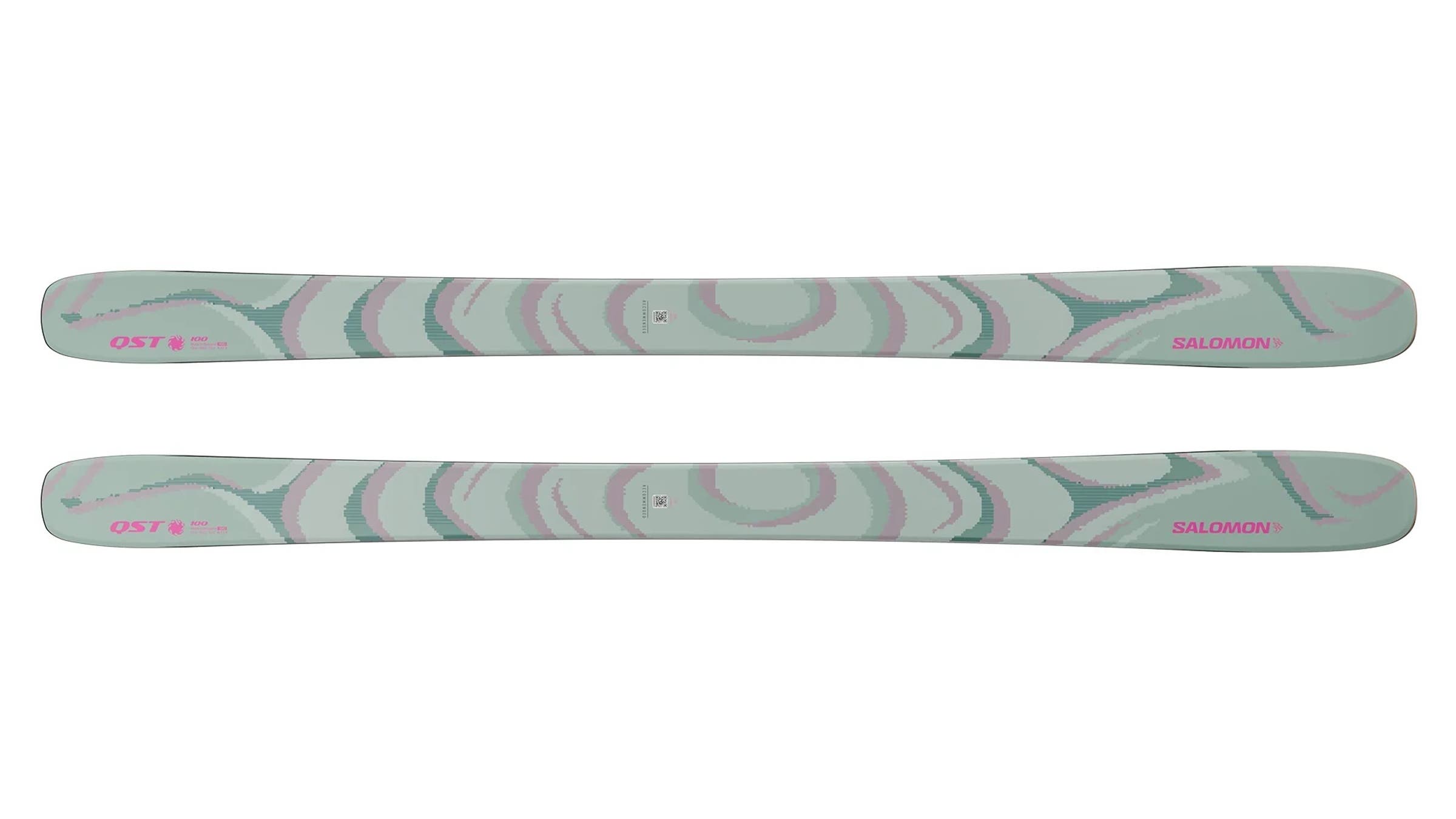
Best Value: Salomon QST 100
Dimensions: 134-100-122
Lengths: 148, 156, 164, 172, 180, 188 cm
Pros and Cons
⊕ Dependable in crud
⊕ Suited to all terrain
⊕ Great value
⊗ Planky
⊗ Lacks forgiveness
Testers agreed the new Salomon QST 100—a unisex model that replaces last season’s QST Lumen 98—is a dependable and balanced ski that is best suited for experts. What they did not agree on, however, was whether or not the new and stiffer iteration suited their style. Many appreciated its predictability; others felt it lacked playfulness. Either way, this is definitely not the same nimble and forgiving ski of the past. “Hard charging but planky,” said Telluride-based tester Kelli Gleason.
The new QST 100 is 2 millimeters wider than the Lumen 98, has a poplar wood core, and incorporates injected cork in the tip and tail for a smoother and damper ride. While it didn’t earn top marks in any one criteria, testers recommend it for its dependable performance in crud, above-average flotation, and versatility across terrain type—from firm groomers to chalky moguls to soft bowls.
Across the board, testers felt it wasn’t the easiest ski, noting that it felt like it took work to make turns in tight terrain, and tied it with Nordica’s Santa Ana 102 for being one of the least forgiving skis we tested. But that won’t deter expert chargers, will it? And you can’t beat that price.
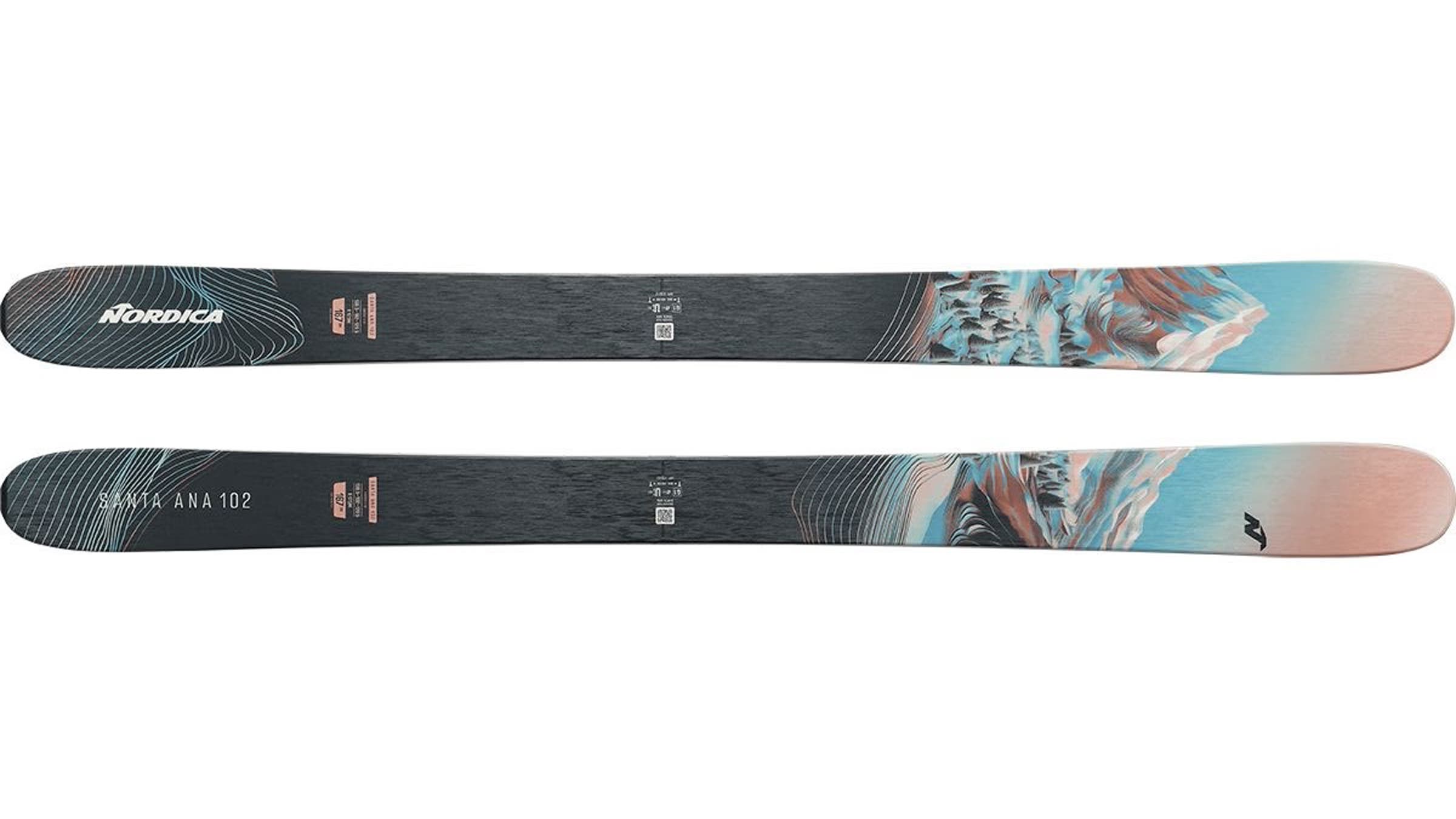
Best for Firm Conditions: Nordica Santa Ana 102
Dimensions: 129-101-119 mm @ 161 cm
Lengths: 155, 161, 167, 173, 179
Pros and Cons
⊕ Grips well hardpack
⊕ Loves speed
⊗ Not the most forgiving
⊗ Lacks playfulness
The Nordica Santa Ana 102 is one of our top wide all-mountain ski picks because of how responsive and confidence-inspiring it is, especially on hardpack. While Nordica’s latest iteration of this tried-and-true model, which debuted last year, is by all accounts slightly more forgiving than its predecessor, this is still a ski best suited for advanced and expert women. It’s balanced, dependable, and aggressive for those who know how to wield it, and it performs best for those who aren’t afraid to fire a muscle or two.
A metal laminate dampens vibration and gives it a stuck-to-the-snow feeling, and a generous rocker helps initiate turns easily and float in powder. It’s not our testers’ first choice in moguls, where it can feel stiff and buck you off your line, but in wide-open powder bowls or set-up heavy crud, there was no board with a steadier feel. Samantha Berman, a 5’4” tester and SKI’s executive editor, noted it felt a little burly, but, “for women who like to ski fast at high speeds, it fits the bill.”
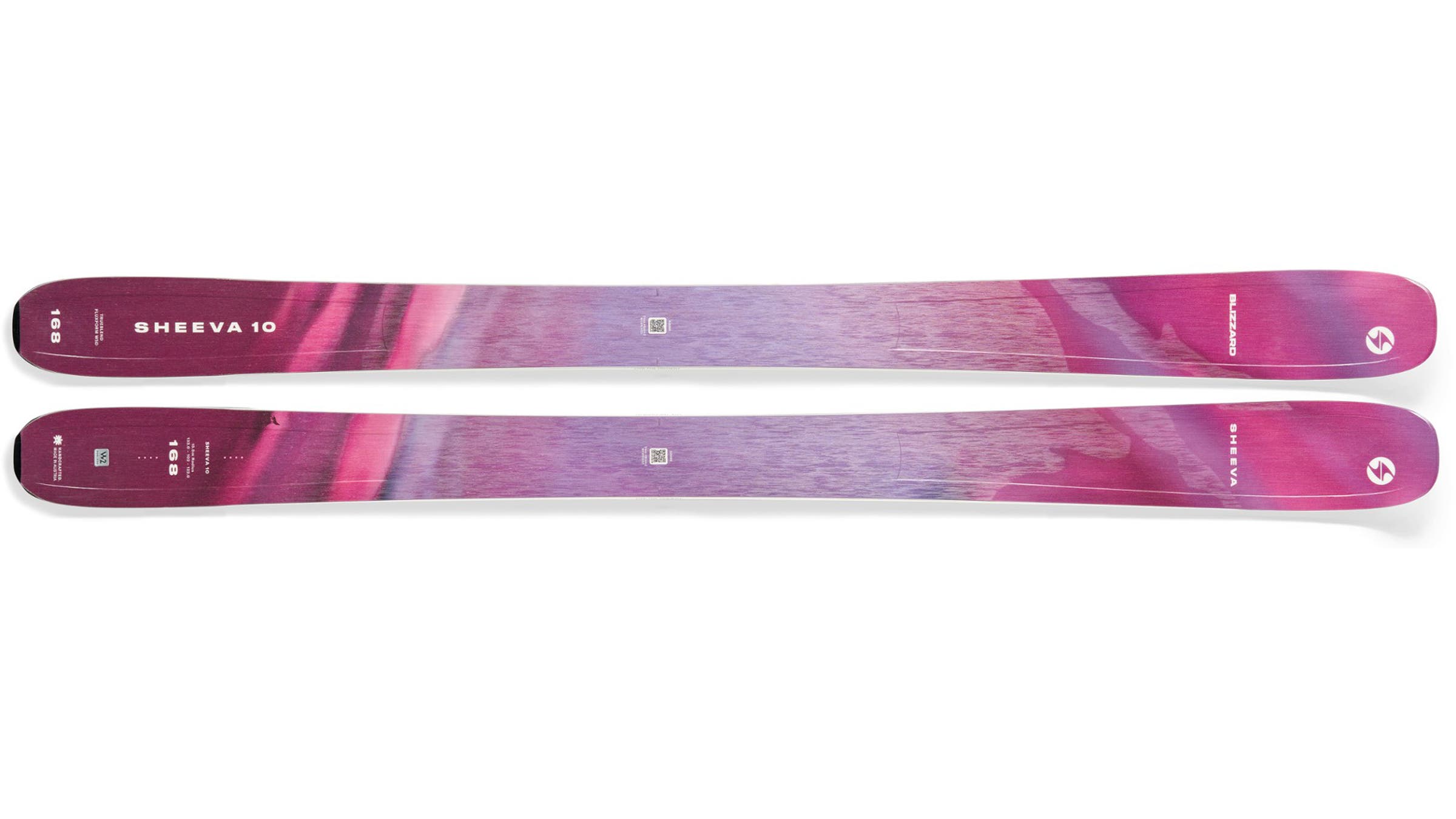
Best for Powder: Blizzard Sheeva 10
Dimensions: 133.5-102-122.5 mm
Lengths: 156, 162, 168, 174, 180 cm
Pros and Cons
⊕ Great in powder
⊕ Adapts to all terrain
⊗ Prefers longer turns
⊗ Not the quickest underfoot
The Blizzard Sheeva 10 has long been a tester favorite, winning hearts for being a stable and predictable ride that’s also not afraid to be the life of the party. Its top scores in flotation, hard-snow integrity, stability at speed, and forgiveness give you a good snapshot of its versatility, because it nails seemingly diametrically opposed qualities across the board. It floats, knifes, craves speed, weaves through trees, and butters beautifully whenever you’re ready to just loosen your buckles and cruise.
That’s what makes it so well-suited to a wide range of skier abilities: You can dial in your level by adjusting the length. It has a wood core with a graduating flex pattern that’s enhanced by metal where it matters most (underfoot), making the ski easy to turn yet reliable on edge. Some testers felt it wasn’t quite as nimble as they would have liked and that it preferred longer turns, but most felt it to be a benchmark for versatility in this category. “It’s playful but packs enough punch to hold up on yesterday’s chop,” said Lauren Engle, a 5’4” skier from Vail who owns Outdoor Divas. If you charge hard but want a ski that responds playfully to your every move, this is the ski for you.
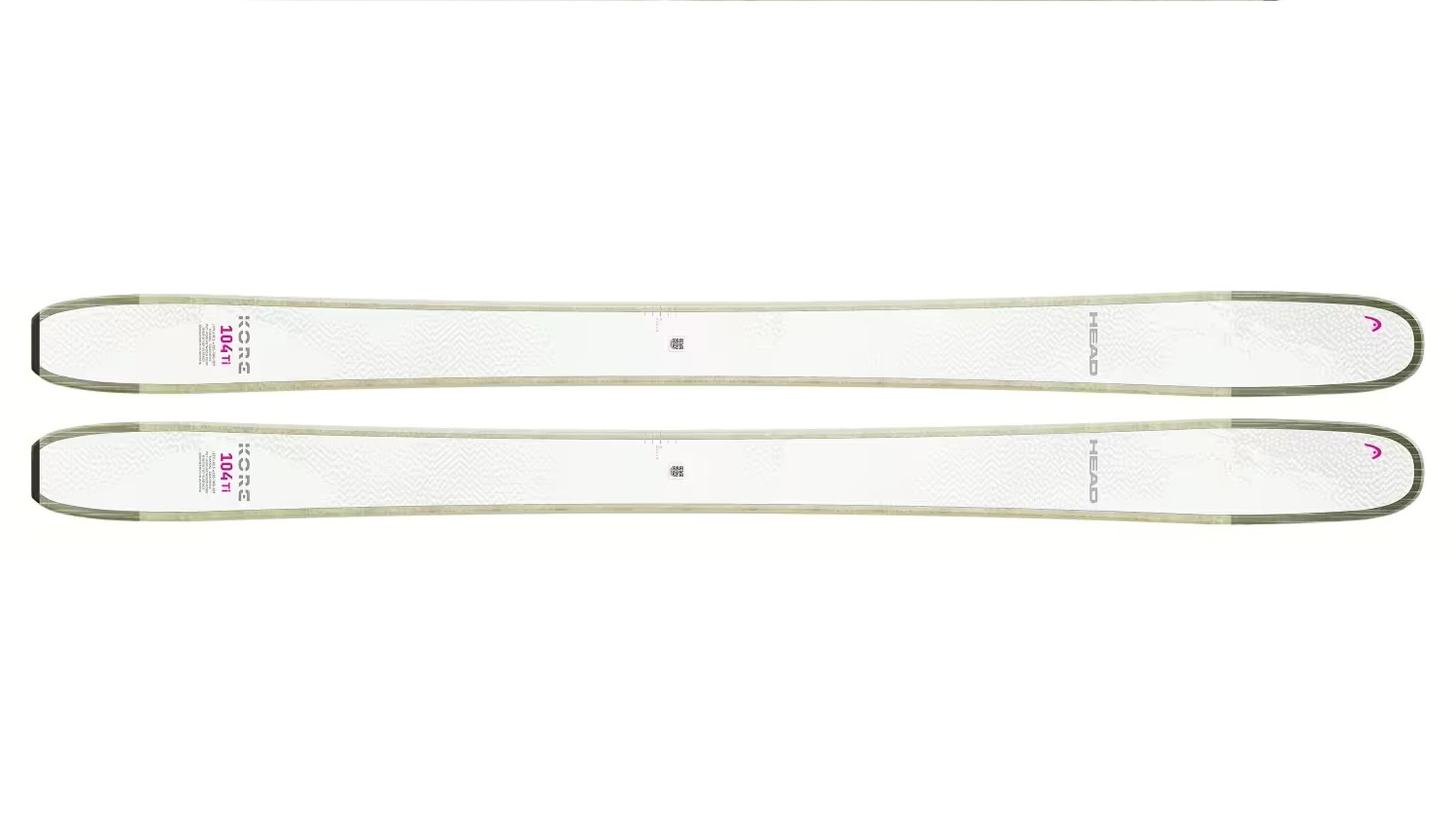
Most Forgiving: Head Kore 104 Ti W
Dimensions: 131-103-123 mm
Lengths: 156, 163, 170, 177 cm
Pros and Cons
⊕ Approachable for most
⊕ Smooth in rough terrain
⊗ Tip chatter at speed
⊗ Might not be exciting enough for experts
This is not the Kore of yore: Head has revamped their bestselling line across the board, most notably replacing the light and stiff carbon laminates with not-so-light metal ones to give the new Kore Ti models some much-needed heft. Those who loved the previous version’s light feel might notice a slight difference in quickness, but most testers felt the benefits of calming, vibration-damping metal is well worth the small sacrifice.
The only difference in the women’s version of the Head Kore 104 Ti W is that it starts with a lighter weight wood core; the rest—two sheets of Titanal, full layup of graphene (a strong yet lightweight material), and fiberglass laminates—are the same as the unisex model. A few testers griped that the Kore 104 Ti W didn’t love making short turns, the new damp feel might not be lively enough for experts wanting rebound, and the new rocker profile made the ski chattery and disconcerting at speed.
But all agreed that the new Kore 104 Ti W is an improvement when it comes to smoothing out rough terrain and not balking at push-piles. It’s a solid choice for intermediates on up who ski all over the mountain. “The right mix of power and playfulness for a smooth, predictable ride,” said Telluride, Colorado-based tester Kelli Gleason.
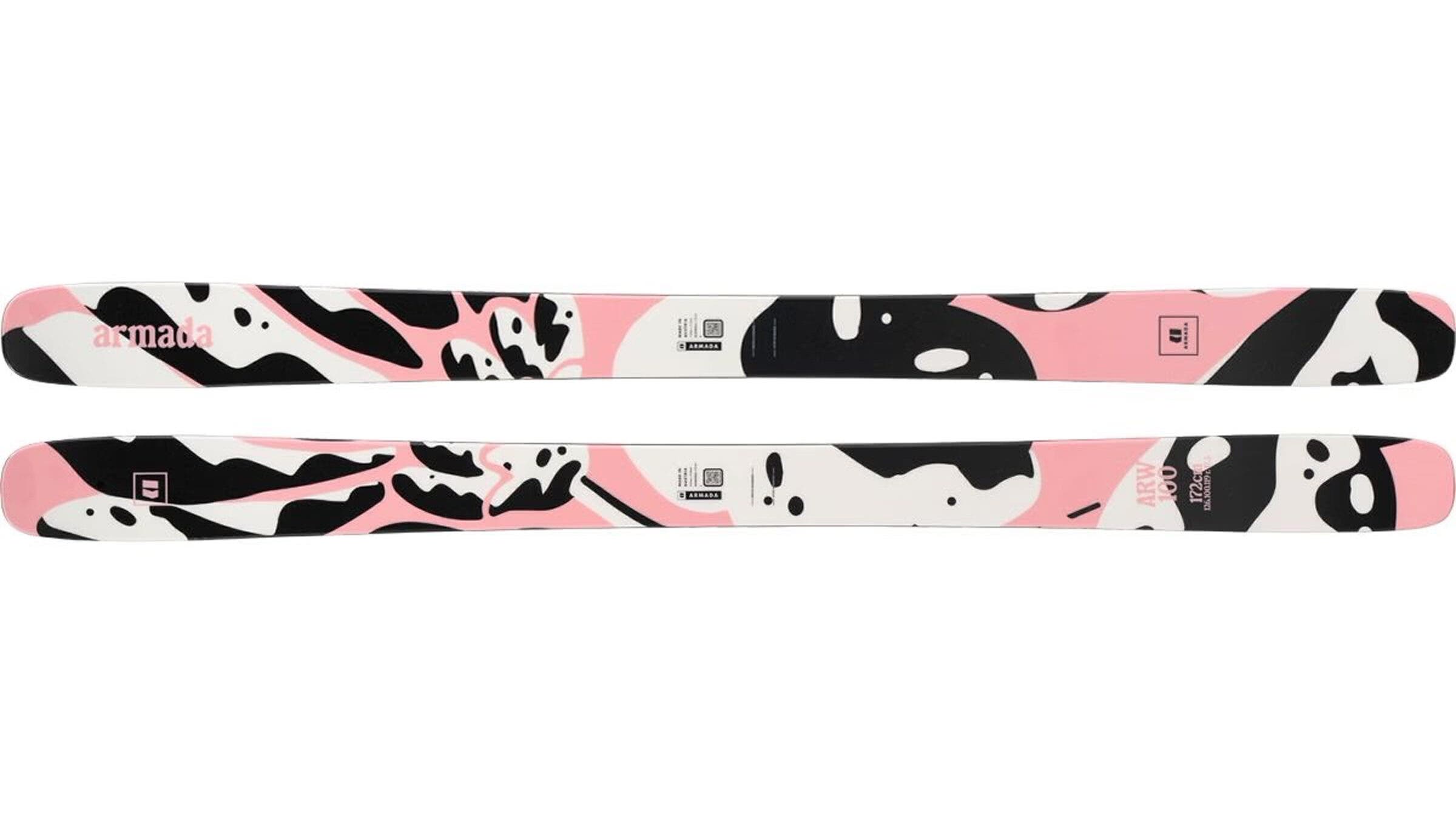
Most Playful: Armada ARW 100
Dimensions: 125-100-118 mm
Lengths: 158, 165, 172, 179 cm
Pros and Cons
⊕ Great in bumps
⊕ Approachable for aspiring experts
⊗ Lacks edge-grip on hardpack
⊗ Aggressive skiers may overpower it
The Armada ARW 100 was so quick and playful (earning a No. 1 in both criteria) that testers described the way it moved through moguls and tight trees as dancing rather than skiing. Disco stick, indeed: Its relatively soft flex and metal-free construction gives it energy to spare, and a 3-D tapered sidewall cuts down on swingweight and accounts for all that maneuverability. It’s also one of the better suited options for lesser experts, too, earning high marks in the forgiveness criteria. On the flip side of that coin, some testers felt it wasn’t aggressive enough for experts or heavier skiers. They also noted that the ARW 100 shines in soft snow only; testers felt it didn’t have the backbone to grip on hardpack or bust through crud, rating it low in our hard-snow integrity and crud performance criteria.
But for those who are aspiring big-mountain skiers or who have a quiver of skis at the ready, it’s a fun ride that never takes itself too seriously. “Easy to ski, as progressive as you want to make it,” said Ody Loomis, a patroller at Big Sky, Montana. “This is a grow-with-you ski.”
More Skis We Recommend
The following wide all-mountain skis are models that excel in specific areas like quickness or stability at speed, offering strong alternatives for skiers with specific performance preferences.
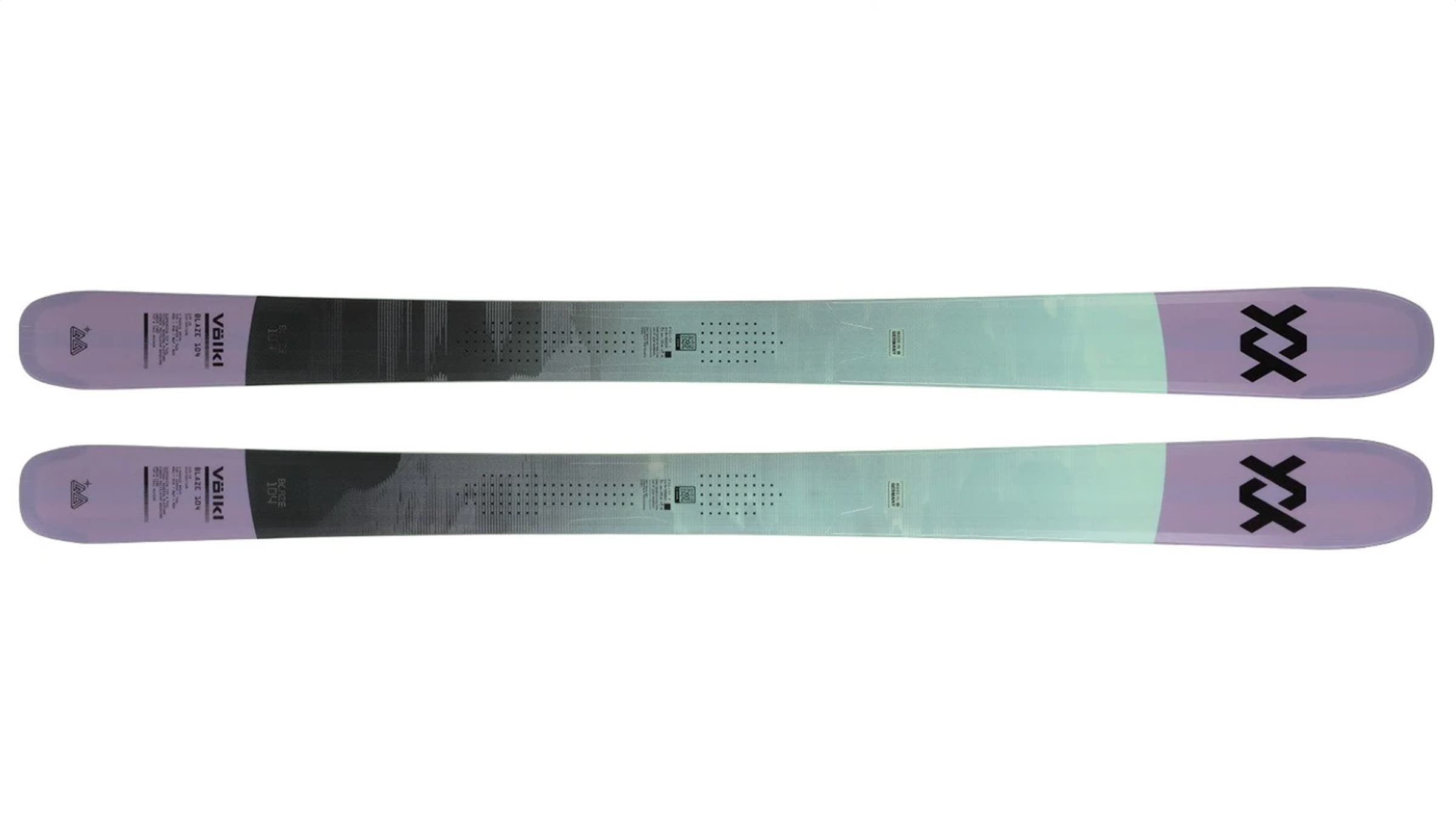
Völkl Blaze 104
Dimensions: 143-104-128 mm
Lengths: 158, 165, 172, 179, 186 cm
Pros and Cons
⊕ Busts through crud
⊕ Grips on hardpack
⊗ Chattery at speed
⊗ Can be overpowered
Völkl divides its all-mountain freeride skis into two camps: “speed” and “light.” The Blaze 104 falls into the latter, thanks to its lighter construction that only includes metal in a Titanal plate directly underfoot. Testers appreciated its impressive strength-to-weight ratio, giving it a peppy, lively feel while still dependable. It dives effortlessly through bumps, arcs confidently on hardpack, and even has enough backbone to bust through crud.
Surprisingly forgiving, the Blaze 104 is accessible for intermediates while still offering plenty for advanced skiers—a pleasant twist for those who expected Völkl’s traditionally precise, demanding feel. Its do-anything attitude inspired confidence across all types of terrain, though some testers found it a bit too light for heavier, more aggressive skiers. At higher speeds, it can feel twitchy, and its wide shovel occasionally chatters, but for most skiers, the Blaze 104 delivered fun, energetic performance everywhere on the mountain.
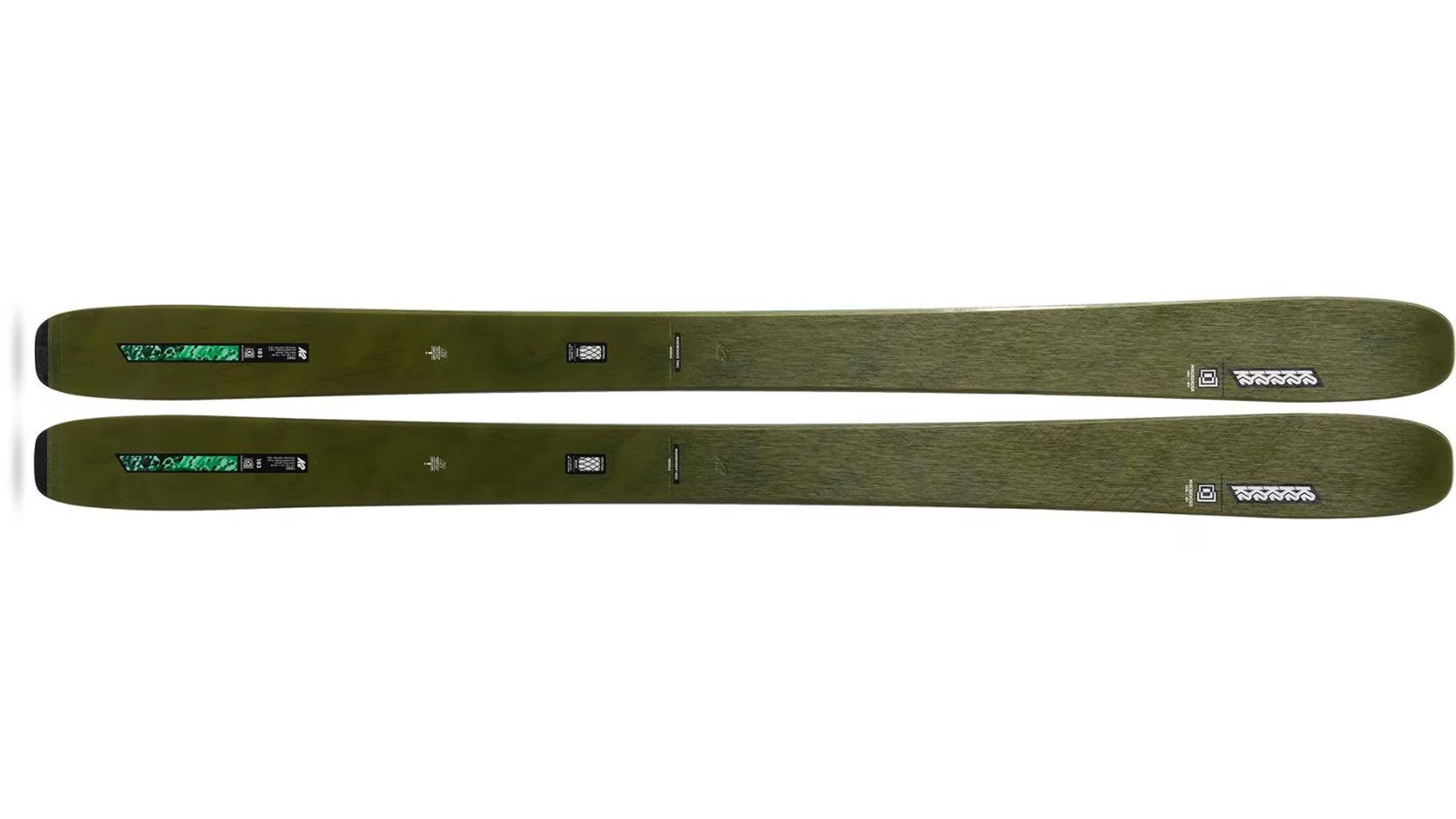
K2 Mindbender 106C W
Dimensions: 138-106-127
Lengths: 156, 162, 169, 176
Pros and Cons
⊕ Good for intermediates
⊕ Loves soft snow
⊗ Has a speed limit
⊗ Gets deflected in crud
Testers took the K2 Mindbender 106C W all over Big Sky—from firm groomers to chalky moguls to boot-top fluff in the trees—and found it to be an easygoing, approachable ride. It shines in softer snow, where its playful personality comes through, but it can get deflected on hardpack. Still, it grips and carves reasonably well as long as conditions stay smooth and free of push piles.
Its rocker-camber-rocker profile makes turn initiation effortless, while just enough carbon adds stiffness to the lightweight wood core to keep it capable when the snow firms up. Best suited for intermediates and advanced skiers, the Mindbender 106C W favors slower speeds and mellow cruising over aggressive charging. Overall, it’s a lightweight ski built for fun, not a fight—perfect for skiers who want to play in soft snow and don’t mind calling it a day when conditions turn rough.
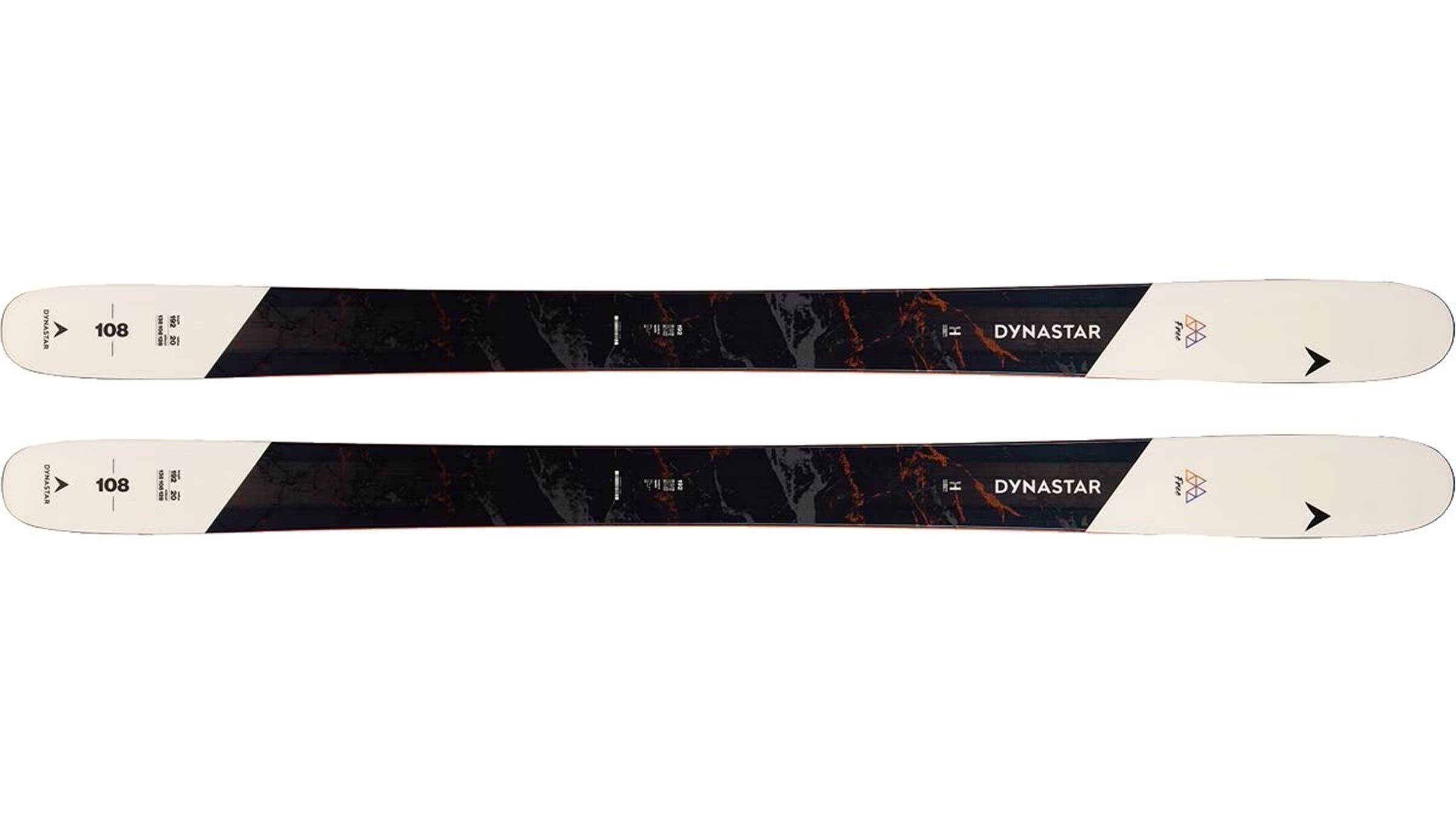
Dynastar M-Free 108
Dimensions: 138-108-128
Lengths: 162, 170, 178, 185, 192
Pros and Cons
⊕ Wide enough for deep days
⊕ New-school smeary feel
⊗ Not great on hardpack
The Dynastar M-Free 108 is the widest ski we tested in this category, so it came as no surprise that it excelled in soft snow while lagging a bit on hardpack. Testers ranked it near the top for flotation, but it landed lower in versatility and hard-snow performance.
This ski favors pivoting and smearing over a true carve, making it a playful, free-spirited ride when the snow is deep. On storm days, it delivers a fun, surfy feel that powder lovers will appreciate.
However, testers felt that it was a little too one-dimensional and best suited for skiers who live in consistently snowy areas or those who embrace a new-school style. Those seeking a true all-mountain ski with strong hardpack chops should look elsewhere.
Best Wide All-Mountain Skis Comparison
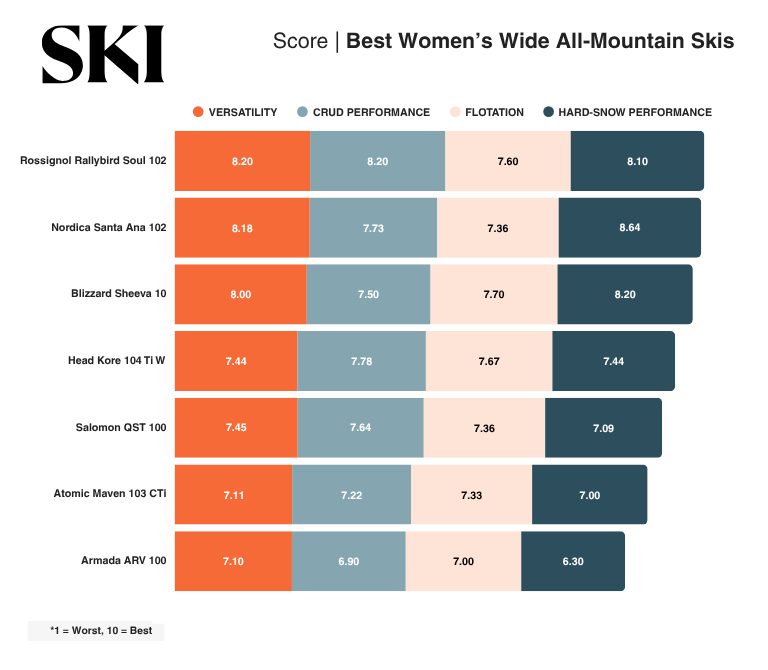
About the SKI Test
- Number of skis tested: 13
- Number of testers: 12
- Testing location: Big Sky, Montana
- Tester range: Ages 27- 52 | Height: 5’2” – 6’ | Weight: 112-180 lbs
Each year, SKI’s editorial team conducts one of the most rigorous and trusted all-mountain ski tests in the industry. At the 2025 SKI Test in Big Sky, Montana, 12 experienced skiers from across the country tested 16 women’s all-mountain skis in real-world resort conditions. To reduce subjectivity, all testers skied each model on the same day, in the same conditions, and submitted digital scorecards evaluating each ski across nine criteria:
- Versatility
- Crud Performance
- Stability at Speed
- Responsiveness
- Carving
- Quickness
- Forgiveness
- Playfulness
- Flotation
When judging the best wide all-mountain skis for women, we place the greatest emphasis on crud performance and flotation—two key indicators of a top-tier wide all-mountain ski. The six winners on this list earned consistently high marks across all categories, especially those two. The skis included in the “More Skis We Recommend” section are models that excel in specific areas like playfulness or forgiveness, offering strong alternatives for skiers with specific performance preferences. Learn more about our testing methodology and scoring criteria here.
Why You Can Trust Us
Our ski reviews are the result of the largest, most rigorous on-snow test in the industry. We never charge brands to participate and don’t guarantee coverage—our annual SKI Test is a fully independent editorial project designed to deliver objective, in-depth reviews. Our 12 expert testers include ski instructors, ski patrollers, ski shop owners, hardgoods buyers, ski technicians, and race and freeride coaches. We handpick this crew for their professional expertise and intentionally include a range of body types, ages, and home mountains to reflect the broader ski community. Bottom line: There’s no pay-to-play here—just honest feedback from people who know skis. Meet some of our veteran testers below:
Kimberly Beekman
Age: 49 | Height: 5′4″ | Weight: 112 lbs
Kimberly Beekman has been testing skis and writing gear reviews for longer than she’d like to admit. She’s a former editor of SKI and freelance contributor to both SKI and Outside. She lives in Steamboat Springs with her wonderful daughter and terrible cat.
Avery Pesce
Age: 42 | Height: 5′6″ | Weight: 138 lbs
Originally from the North East, Pesce now lives in Midway, Utah, but still calls the ski areas of Vermont and New Hampshire home. She’s an expert skier with an aggressive style that she applies to any and all types of terrain and snow conditions. As the head ski buyer for Boston Ski & Tennis in Newton, Mass., she knows a thing or two about skis—how they’re built, how they perform, and who they’re best suited to.
Courtney Harkins
Age: 34 | Height: 5′8″ | Weight: 135 lbs
Courtney Harkins grew up ski racing, starting on the icy slopes of New England and finishing at the University of Colorado at Boulder. She now lives in Park City, Utah and works as the director of marketing and communications for the U.S. Ski & Snowboard Team. When she’s not traveling with the team, her home mountain is Deer Valley Resort, where she loves to arc turns on groomers, but also knows all the secret spots for days-old powder.
Frequently Asked Questions
What are wide all-mountain skis?
Wide all-mountain skis are slightly wider than typical all-mountain skis, with waist widths that hover between 100 to 110 millimeters. While they’re still versatile all-mountain skis, they cater more to soft snow and powder and less to skiing groomers than narrower all-mountain skis.
What’s the best wide all-mountain ski for women?
SKI’s expert testers named the Rossignol Rallybird Soul 102 the best wide all-mountain ski for women. It’s powerful yet easy to ski, comfortable yet precise on edge, energetic yet dependable and predictable in variable conditions. Read more here.
What’s the best wide all-mountain ski for powder?
The Blizzard Sheeva 10 outperformed all the other all-mountain skis we tested in powder. With a 102-millimeter waist, lighter construction, and plenty of tip and tail rocker, the Blizzard Sheeva 10 is made to float through the fluff.
What’s the best width for all-mountain skis?
All-mountain skis come in a variety of waist widths ranging from 80 millimeters on the narrow side to 110 millimeters on the wider side. The best waist width for you depends on what type of skiing you do and what performance characteristics you prefer in a ski.
If you primarily ski off-piste in crud or on slopes with more than six inches of powder, you’ll want a wide-waisted all-mountain ski (around 100 to 110 millimeters). That will give you a wider and sturdier platform underfoot. If you live somewhere that doesn’t see a ton of snowfall, or if you primarily keep to groomed terrain with the occasional venture off-piste, a ski with a 80- to 95-millimeter waist will offer better performance on hard snow and ice, in moguls, and on edge on groomed terrain.
Do I need a wide all-mountain ski?
Wide all-mountain skis are better suited to skiers who primarily ski off-piste at resorts that see abundant snowfall. Wide all-mountain wide skis generally handle powder and crud better than all-mountain narrow skis. However, wider skis do sacrifice some edge performance, so skiers who care about making precise turns and carving on groomers occasionally should look to narrower all-mountain skis.
What’s the difference between men’s and women’s skis?
In truth, most skis are unisex and not gender-specific. Many brands produce the ski with the exact same construction technologies for both genders, but often create two different top sheets to appeal to men vs. women. A handful of brands are making truly women’s-specific skis, where the ski takes a woman’s physique into account when building the ski. Men and women can ski on the same ski but may want to choose different lengths depending on their height and their skiing ability.
More from the 2026 Winter Gear Guide
The Best Women’s All-Mountain Skis
The Best Women’s Frontside Skis
The Best Women’s Carving Skis







